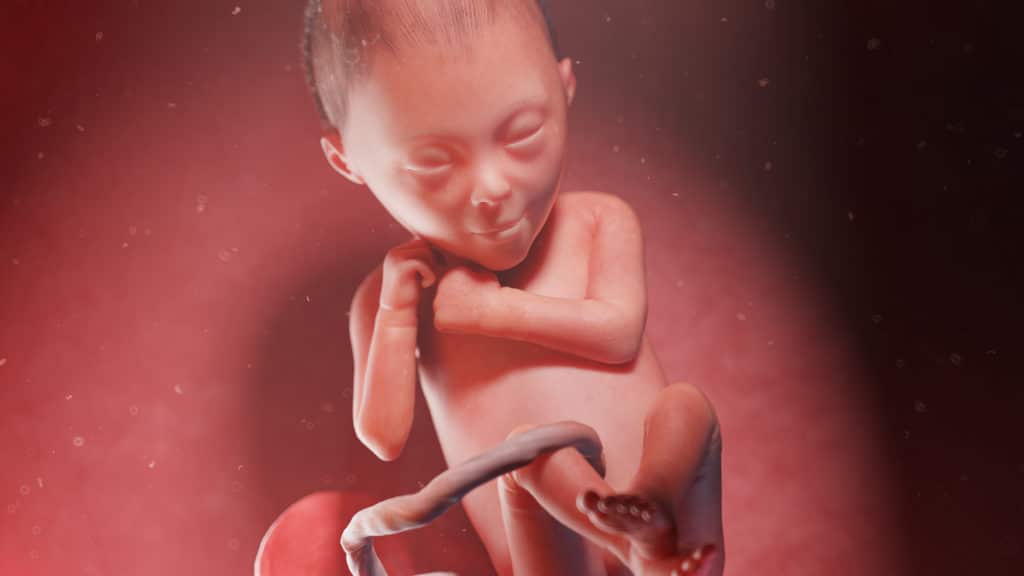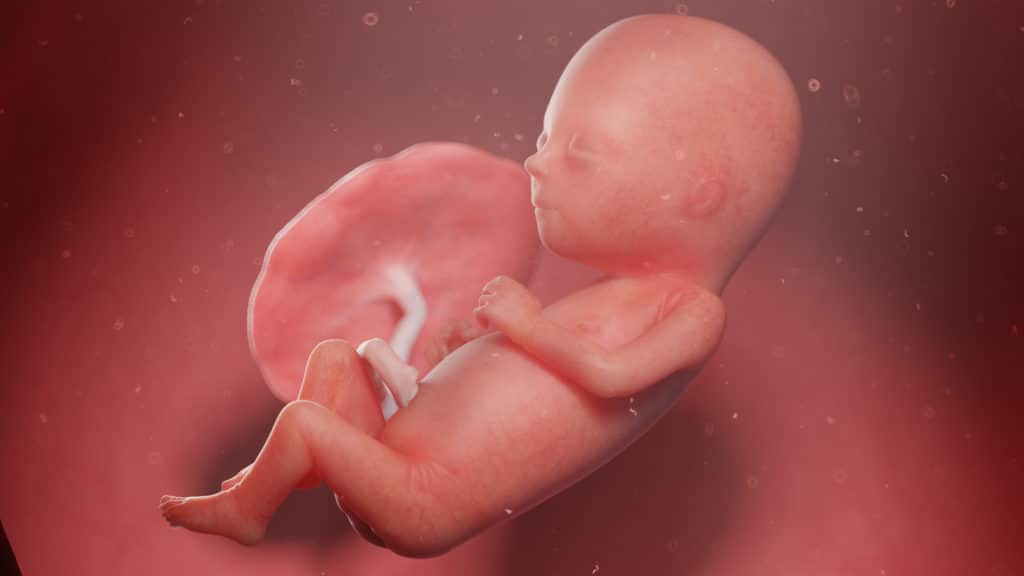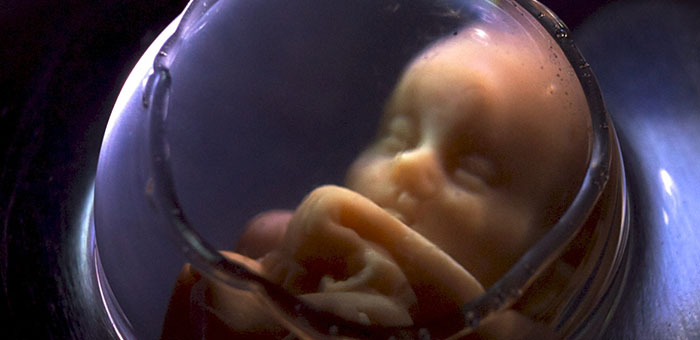By Susan Ciancio
For thousands of years, people have found ways to kill unwanted babies. From taking pills to tearing a child to pieces prior to birth to even throwing a baby off a cliff, it often seems that any method will do. Parents seek only the end result—being rid of the baby.
All abortion is tragic because all abortions result in the loss of a unique human being. But one of the most heinous and horrific ways to kill a baby in the second or third trimester is commonly called a partial-birth abortion—or in medical terms, an intact dilation and extraction abortion (D&X).
What Is Partial-Birth Abortion?
In a partial-birth abortion, the abortionist begins delivering the baby but stops partway. Holding half of the baby’s body still inside her mother’s body, he then kills her by jamming scissors into her neck.

Drawings of a partial-birth abortion. Credit: Jenny Westburn, CC BY-SA 3.0
It sounds like something out of a horror movie, but it’s real. And it’s been around for decades.
Writing for the USCCB, Susan E. Wills states:
Although apparently a well-kept secret within the abortion community for over a decade, partial-birth abortion first came to most people’s attention in 1993. That is when a paper by Dr. Martin Haskell of Ohio, delivered at a September 1992 meeting of the National Abortion Federation (NAF), became public.
In 1992, Haskell, who claimed to have performed over 1,000 partial-birth abortions, detailed his procedure in a paper. To give readers a realistic view of this gruesome procedure, a 1996 congressional record factsheet entitled “A Closer Look at Partial-Birth Abortions” reprinted his directions.
According to Haskell:
With a lower [fetal] extremity in the vagina, the surgeon uses his fingers to deliver the opposite lower extremity, then the torso, the shoulders and upper extremities. The skull lodges at the internal cervical os [the opening to the uterus]. Usually there is not enough dilation for it to pass through. The fetus is oriented dorsum or spine up. At this point, the right-handed surgeon slides the fingers of the left hand along the back of the fetus and hooks the shoulders of the fetus with the index and ring fingers (palm down). [T]he surgeon takes a pair of blunt curved Metzenbaum scissors in the right hand. He carefully advances the tip, curved down, along the spine and under his middle finger until he feels it contact the base of the skull under the tip of his middle finger. [T]he surgeon then forces the scissors into the base of the skull or into the foramen magnum. Having safely entered the skull, he spreads the scissors to enlarge the opening. The surgeon removes the scissors and introduces a suction catheter into this hole and evacuates the skull contents.
Take a moment to let that image fill your mind. These abortions are typically done in the second and third trimesters (13 weeks to full term), sometimes after the baby has reached viability. Because of improvements in medical interventions, a baby is viable after 24 weeks, and depending on the capabilities of the hospital, maybe as early as 22 weeks.

A baby at 24 weeks
This sick and twisted method of abortion has rightfully been the source of contentious debate for decades.
Frequency of the Procedure
There really is no way to know how often this procedure has been done in the past, though according to Wills: “Dr. William Rashbaum of New York City admits that he has performed 19,000 late-term procedures and that he and his colleagues have used the partial-birth technique ‘routinely since 1979.’ Dr. Martin Ruddock of Ohio told a reporter that he uses the method, but he declined to say how often. The late Dr. James McMahon had done thousands and his partner is likely continuing the practice.”
A 2007 article in the National Library of Medicine states, “The number of [partial-birth] abortions carried out each year in the US is thought to be between 2200 and 5000. They are most often performed in the second trimester.” The number of these types of abortions is “unclear because of problems with definitions and the collection of statistics. Estimates are less than 1%, perhaps as low as 0.2%.”
We must remember that these numbers, though low, are only those that have been reported. Not all states report. And not all abortionists admit to performing them. Kermit Gosnell was an excellent example of this. His “house of horrors” in Philadelphia saw the deaths of an untold number of preborn babies. And he freely admitted to—and even joked about—killing babies with scissors.
Pro-abortionists want women to believe that partial-birth abortions in the second and third trimesters happen only when something has gone wrong with the baby or when the mother’s life is at risk. But we know that this is not the case.
According to Wills:
Dr. Haskell estimates that 80% of his procedures are ‘purely elective.’ One New Jersey doctor explained: ‘We have an occasional amnio abnormality, but it’s a minuscule amount. Most are Medicaid patients…and most are for elective, not medical, reasons: people who didn’t realize, or didn’t care, how far along they were. Most were teenagers.’
Further, by its very nature, a partial-birth abortion—because it takes two to three days to complete—cannot be done in an emergency situation. So if a mother’s life is in immediate danger, the doctor will not perform this type of abortion. In fact, if the mother’s life is in danger, the doctor will likely do all he can to save both her and the baby.
According to the latest CDC Abortion Surveillance Report: “In 2019, the highest proportion of abortions were performed by surgical abortion at ≤13 weeks’ gestation (49.0%), followed by early medical abortion at ≤9 weeks’ gestation (42.3%), surgical abortion at >13 weeks’ gestation (7.2%), and medical abortion at >9 weeks’ gestation (1.4%).”
The report does not break down the type of abortion after 13 weeks, but as we will read below, there are only two types of abortion that can be done after 14 weeks.
So under what circumstances would a woman or doctor choose a partial-birth abortion?
Why Partial-Birth Abortion?
There are only two methods of abortion that can be done after 14 weeks. These are the intact dilation and extraction abortion (the so-called partial-birth abortion) and a more common method called a dilation and evacuation abortion. Both types of abortion begin with the same preparation of the cervix. And because of the size of the baby, both require two separate visits to the abortionist’s office.
On the first visit for either type of abortion, the abortionist prepares the mother’s cervix to dilate. He will insert laminaria—a sterilized seaweed—into her cervix. This absorbs water and swells, which prepares and begins opening the cervix. Then, 24–48 hours later, the mother must return to the office so she can deliver the baby. When the mother’s body is ready, the doctor will further open her cervix so he has access to the baby.
In a dilation and evacuation abortion, the abortionist uses a suction tube to suck out the amniotic fluid. The baby is too big to fit through that tube, so she cannot be sucked out. The abortionist must pull her out in pieces. He does this with a tool called a Sopher clamp. Using this clamp, he grabs onto different parts of the baby and pulls until he has removed the entirety of her body. At this point, he must verify that he has gotten all the baby’s body parts, and he puts her together like a jigsaw puzzle outside the mother’s body.
Conversely, in partial-birth abortion, the abortionist follows the same preparations as described above, but instead of using the Sopher clamp and suction tube, he delivers the baby partway. He then stops the delivery and kills her by stabbing her neck with scissors.
You might wonder why abortionists would use the partial-birth method instead of the dilation and evacuation method. It comes down to the size of the child: “Some abortion doctors use PBA in the middle and last months of pregnancy, when dismembering a child becomes more difficult due to the child’s stronger bones and ligaments.”
If the abortionist cannot pull the child’s limbs apart because the child has grown too big and his bones have become too strong, the doctor may find it a better option to deliver the baby intact. Further, some doctors—and legislators—claim that delivering the baby intact is safer for the mother, as pieces of the baby will not be left inside her, which could lead to life-threatening complications.
Related: Surgical Abortion
Risks
Anytime a woman undergoes such a traumatic and invasive procedure as an abortion, she is at risk of encountering complications. The further along she is in the pregnancy, the more likely she is to have them.
The Guttmacher Institute, the research arm of Planned Parenthood, has reported that “the rate of maternal death for women having an abortion at 21 weeks’ gestation or later [the time frame during which a partial-birth abortion falls] is more than twice the maternal death rate in childbirth.” In addition, “a study published in the New England Journal of Medicine reports 15 to 16 weeks’ gestation as the point at which abortion becomes more dangerous than childbirth.”

A baby at 15 weeks
The organization A Woman’s Right to Know lists several side effects of a dilation and extraction abortion:
- Common side effects include cramping and bleeding.
- Other side effects can include blood clots, damage to the cervix, nausea, headaches, infection, blurry vision, and more.
- Rare complications include hemorrhage, perforation of the uterus, placenta previa in subsequent pregnancies, pulmonary embolism, and even death.
The National Center for Biotechnology Information addresses the risks of abortion in general, stating that major complications include “uterine atony and subsequent hemorrhage, uterine perforation, injuries to adjacent organs (bladder or bowels), cervical laceration, failed abortion, septic abortion, and disseminated intravascular coagulation (DIC).” The NCBI then goes on to say that the risks continue to grow in the days and weeks after the abortion because the body has been through such a traumatic event: “The total abortion-related complication rate of all sources of care including emergency departments and the original abortion facility is estimated to be about 2%. The incidence of abortion-related emergency department visits within six weeks of the initial abortion procedure is about 40%.”
Related: The Risks of Abortion
Due to the heinousness of partial-birth abortion, you might be asking yourself, Shouldn’t there be some sort of law against this? Yes, there should. And there is. But with exceptions.
Supreme Court Decisions
Congress twice passed bills banning partial-birth abortion, but both bills were vetoed by President Clinton. During this time, notorious late-term abortionist LeRoy Carhart was committing abortions in Nebraska.
At the time, Nebraska law banned partial-birth abortion. But Carhart apparently wanted to kill more preborn babies and babies of all gestational ages. Carhart fought the Nebraska law all the way to the Supreme Court. In 2000, in Stenberg v. Carhart, the Court decided that Nebraska’s ban was unconstitutional because it lacked an exception for the health of the mother.
Related: LeRoy Carhart: Secrets of a Late-Term Abortionist
Meanwhile, a new president took office. And in 2003, George W. Bush signed the Partial-Birth Abortion Ban into law. The ban “amends the federal criminal code to prohibit any physician or other individual from knowingly performing a partial-birth abortion, except when necessary to save the life of a mother whose life is endangered by a physical disorder, illness, or injury.”

President Bush signing the Partial-Birth Abortion Ban
Undaunted by this 2003 ban, Carhart, the National Abortion Federation, and Planned Parenthood Federation of America filed a suit in federal court. These judges ruled the ban unconstitutional. The case eventually made its way before the Supreme Court. And in 2007, in Gonzales v. Carhart, the Supreme Court upheld the Nebraska ban, making it a federal ban.
According to Guttmacher, Gonzales v. Carhart “applies across the country, bans ‘partial-birth’ abortion except when the [mother’s] life is endangered and does not contain an exception to protect the patient’s health.”
Like all abortion laws that provide exceptions for the life of the mother, this leaves a lot open to interpretation. And it allows doctors to make a judgment call about the mother’s situation. That is why, up until the Dobbs case in June, abortion was legal up to the point of birth in the US.
Final Thoughts
Upon becoming president, Joe Biden appointed Xavier Becerra as the Health and Human Services secretary. In May 2021, the Catholic News Agency reported that a representative from Florida asked Becerra about partial-birth abortion. Becerra attempted to deflect the question by stating that partial-birth abortion is not the proper medical term, preferring instead dilation and extraction.
He then went on to defend this type of late-term abortion saying it is meant to “protect” the health of mothers. He stated: “Perhaps, if you were to talk about what you probably know as ‘dilation-and-extraction’—which is a procedure used by OB-GYNs like my wife—to care for a woman who is having a difficult pregnancy where there’s a chance that the fetus will not survive, then we could talk about that.”
His comments clearly show what is wrong with the thinking of so many today. They believe that abortion is healthcare. Yet they overlook the fact that abortion kills a baby in a horrific manner.
Abortion is a terrible crime against the smallest and most vulnerable members of our society. Understanding this, we must give voice to the voiceless. If we are to return our culture to a culture of life, we must take action. We speak out against the evil of tearing a baby limb from limb and in stabbing scissors into her neck. We elect pro-life leaders. We defend all human beings. And we never shy away from telling the truth about these horrific actions.
Staying silent will only result in more dead children.
This article has been reprinted with permission and can be found at hli.org/resources/partial-birth-abortion.
